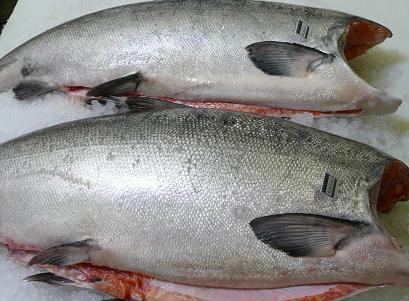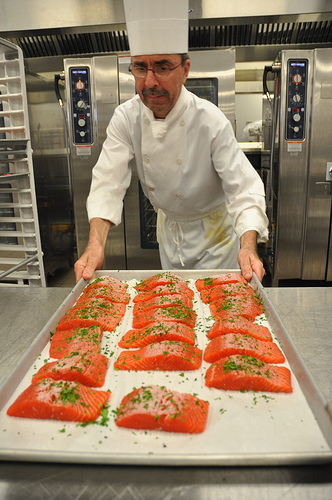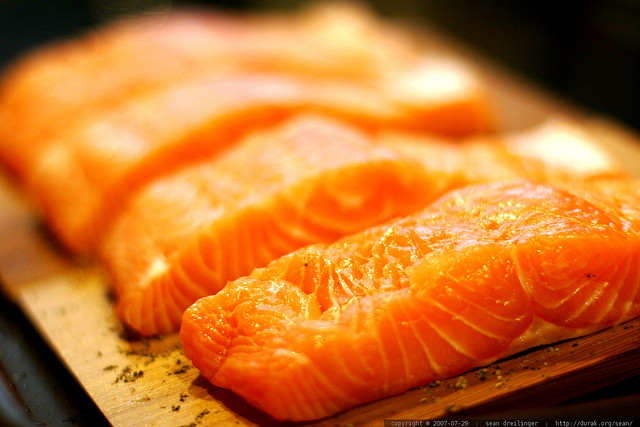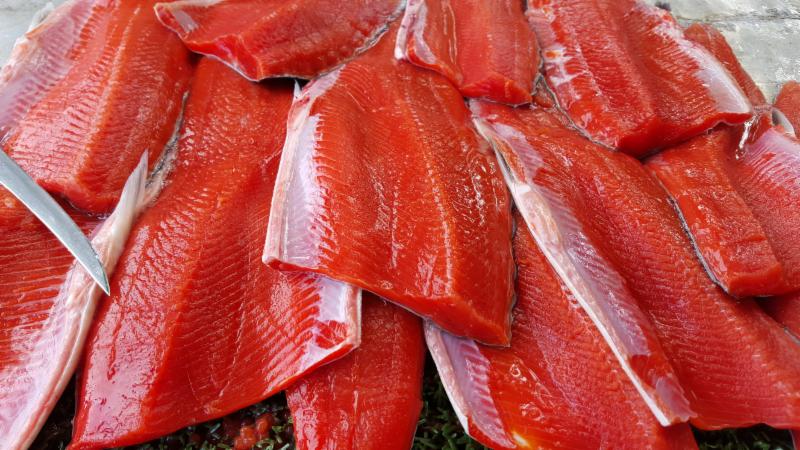|
What Is So Special About Copper River
Wild Alaska King Salmon??
UNRIVALED FLAVOR Copper River Kings season opens in Late May. It is an event that attracts media buzz each year, generating significant consumer demand for the product. Once you've experienced the unrivaled flavor, melt-in-your-mouth texture and distinctive color of Copper River King salmon, you'll know what the hype is all about - this salmon is truly extraordinary and demands to be experienced again and again.
Copper River salmon must travel 300 miles from the ocean, where they have spent their adult lives, through rugged terrain and unspoiled icy waters to reach their spawning grounds, a journey that requires extra stores of energy in the form of fat. It is this fat that not only creates the exceptional flavor and texture of Copper River salmon, but also the high levels of omega-3 fatty acids that make it so healthy to eat.
No farmed fish here ever!!
We Only Harvest Wild Alaska King Salmon -
Loaded With Healthy Omega 3 Oils
The World's Very Finest Salmon!!
 This is a great opportunity to try the World' Most Sought after Wild Alaska King Salmon.
This is a great opportunity to try the World' Most Sought after Wild Alaska King Salmon.
Very Very Limited Supply.
Order Now & Save Over $50.00
Savvy cooks purchase it because it is so inherently rich and flavorful, they prepare it in the simplest fashion--grilled or seared and served with seasonal ingredients such as spring peas, asparagus, baby potatoes, light lemon caper sauce, and wholesome grains.
Simple, Easy Salmon Recipe
Simple Absolutely Delicious Recipe
Broiled Lemon Caper King Salmon -
Take your King Salmon fillet,
remove any bones by using needle nose pliers.
Brush fillet with olive oil and sprinkle liberally with
Alaska Tim's Smoked Salmon Rub.
Let sit for 30 minutes
Place under broiler for 8-10 minutes, skin side down.
Remove and pour
over the top.
(warm sauce ahead of time by placing the jar in hot water for 10 minutes).
This will be your new favorite recipe!!
Pictured above is a Broiled Lemon Caper Copper King Salmon Fillet.
Lemon Caper Salmon Sauce
This is one amazing sauce.
Wow yourself or better yet amaze your dinner party guests with the incredible flavors.
Bon Appetite'
World's Most Sought After Wild King Salmon
 FACT:
FACT:
Longer rivers with difficult terrain like the Copper River, in Alaska, require more stored energy in the form of fats and oils, making Copper River Kings
one of the richest natural sources of heart-healthy omega-3 fatty acids.
"The love affair between fresh, healthy salmon and your taste buds is probably one you'll want to nurture for a lifetime. Do yourself a favor and order Copper River salmon."
Our Copper River King Salmon is absolutely superb!!
These are prime fillets, loaded with flavor and loaded with heart - healthy Omega3 Oils!!
Copper River King Salmon Special Includes:
A Total of #6 Lbs. Of Incredible Fillets!!
Broil, Bake , BBQ - Prepare Anyway You Like.
Wild Alaska Copper River King Salmon Special
Includes:
Regular Price is $299.70
Sale Price is $249.50 !!
~~~~~~~~~~~~~~~~~~~
is your source for Premium Wild Alaska Seafood. We carry a full line up of hard to find Wild Seafood products. We are a small family run seafood company located in Soldotna , Alaska. We catch the fish locally, process it and ship it directly to households and restaurants across the U.S. & Canada.
Free Fedex Shipping Included!!
Buying Direct is your assurance of getting the Very Best & Freshest Wild Seafood on the Planet.
Unique Hard to Find Items:
~~~~~~~~~~~~~~~~~~~~~~~~~~~~
More Important Nutritional Information
King Salmon Nutrition
In addition to ample protein, king salmon offers abundant omega-3s, as well as unrivaled levels of Vitamin D and astaxanthin (as-tuh-zan-thin) ... a carotene-class red-orange pigment with rare health benefits.
These amounts are the averages per 6 oz portion, and will vary annually and from fish to fish:
-
Omega-3s - King salmon averages 2,200mg per 3.5-oz. serving, which is several times more omega-3s than in many fish oil capsules.
- Vitamin D3 - About 400 IU in the optimal D3 form, which is more than most other fish, and more than any fortified food, approaching the child-to-adult US RDA of 600 IU.
- Astaxanthin - About 4mg (red king). This red-orange pigment is a carotene-type nutrient with unique health benefits. Astaxanthin content varies by color with Red King portions have the most.
-
~~~~~~~~~~~~~~~~~~~~~~~~
WHY DOES COPPER RIVER SALMON TASTE SO GOOD?
Well, it turns out, the answer comes down to location, location, location. Anyone lucky enough to be served a filet of Copper River salmon will immediately notice its bright orange or red color, firm texture, and succulent taste. Truly, this is fish so flavorful that any added sauce or garnish just gets in the way. Below, we get into what makes it that way, and share some foolproof tips for selecting the perfect salmon.
What makes them particularly unique and flavorful, however, is the journey they take to get there. The Copper River watershed represents a truly punishing voyage, as it is over 300 miles from Prince William Sound to the salmon's original spawning pools.
Not only that, but the water itself is something else-this is a wild, gushing river of icy glacial runoff from the imposing Chugach and St. Elias Wrangell Mountains.
It takes a lot of muscle to make it, not to mention a lot of fat. Here's another fun fact: salmon cease to eat when they begin their freshwater pilgrimage.
That means any salmon caught on the Copper River watershed will be dense with the same fat linked to a moister texture and better taste in preparation for the grueling miles ahead.
In order to protect their catch and its sustainability, fishermen on the Copper River use the best available practices when harvesting salmon. After being caught, Copper River salmon are bled, iced and processed within hours of harvest

FARM-RAISED VS. FRESH-CAUGHT SALMON
Wild Salmon is one of the healthiest fish in the world to consume - Wild Alaska Salmon are packed with omega-3 fatty acids, are high in protein and low in saturated fat. We're talking a wonder food in terms of heart health benefits and low cholesterol without sacrificing one iota of taste.
While both Atlantic farmed salmon and wild Pacific salmon share some of these benefits, popular species of wild salmon (around 80% of which is caught in Alaska) taste better and are much lower in potential toxins.
The maxim "You are what you eat" is constantly bandied about these days, and for good reason. It applies not just to humans but to the animals they eat, including salmon.
Farmed salmon, which spend their lives swimming around in marine net pens-or, far less frequently, in land-based recirculating aquaculture systems-are given formulated fish pellets on a regular schedule. Recently it was discovered that one of the largest producers of fish pellets was blending into the pellets Pork By-Products.
If you are consuming Salmon for the health benefits, avoid farmed fish at all costs. (I know! But if we go off on that tangent, I'll never get around to answering the question.)
Wild salmon, on the other hand, forage in the open ocean for zooplankton, squid, shrimp, and other small crustaceans, and/or little fish such as sand lance. They are anadromous-that is, even though they spend much of their lives at sea, they spawn in freshwater rivers-and are genetically adapted to return to their natal rivers to reproduce. Researchers say that by using the Earth's magnetic field as a navigational guide, wild salmon can identify one stream out of thousands.
Once salmon enter freshwater on their journey upriver to spawn, they stop feeding and survive on stored energy reserves. Therein lies the basis of the Wild Alaska Salmon mystique.

This comes back to the life cycle of salmon. In the wild, salmon hatch in fresh water and spend a year or more feeding before swimming downstream to the ocean. Depending on the species, the fish then spend 1-7 years in the sea before - quite amazingly - heading back to the same exact river or stream of their birth to spawn. This means they have to swim vigorously upstream for miles and miles.
The larger species of salmon have a longer journey and colder waters to combat, so they store huge reserves of energy in the form of fat. In turn, the stored fat correlates to their delectable taste and high nutritional value. Wild salmon are also distinguished by their deeper red color, which is due to a diet rich is carotenoids (the same antioxidant pigment that dyes carrots). All in all, farm-raised salmon and Wild Alaska Salmon have very little in common. Farmed Salmon, none of which is raised in Alaska, (try Chile or Norway) have a tough time competing in this race, as their fat composition builds from a less natural diet of grain,pork by products and vegetable oils.
Which Wild Alaska Salmon Is Right For Me?
The 3 most sought after species of wild salmon is the King (also known as Chinook), followed by Sockeye and Coho.
(the other two species, pinks and chum, are suitable for canning).
Headed by the Kings, which can weigh in at up to a whopping 90 pounds,although the average king weighs 30 lbs., these three species of salmon spend years maturing in the open ocean foraging on what mother nature provides. Their flesh is also the densest in carotenoids and they face the most arduous journeys during spawning season.
Kings stay at sea longer than other salmon species, which allows adults to reach a good 20 pounds or more. They spawn in large, deep, fast-moving rivers, so they have the greatest need for stored energy; that's why the omega-3-enriched fat of a king can often exceed 20 percent-more than that of any other wild fish. Copper River kings are particularly fatty, creamy flavored, and rich.
Sockeyes, one of the most abundant salmon species, spawn in lakes as well as rivers and can spend up to three years building mass in the ocean before migrating to their natal river. Sockeyes have deep-red flesh, and even though they're second to kings in their total fat content, they have a cleaner flavor and firmer texture, which I (and many salmon lovers) prefer.
Cohos universal popularity is based on a very mild flavor profile and occupy the midrange on the fat scale. They range in size from 8 -18 lbs. According to the U.S. Fish and Wildlife Service, the ability to jump over obstacles, such as beaver dams and waterfalls, allows cohos to migrate farther upstream than other salmon can. In a stream's higher reaches, the water is shallower, and there are fine gravels to nest in. Cohos have a milder, more delicate flavor than kings or sockeyes.
All three vary in taste - the King the most buttery, Sockeye more intensely flavorful, and Coho the mildest. Sockeye and Coho make for great grilling, while the King's flavor is perfect for cedar plank cooking, broiling or baking.
~~~~~~~~~~~~~~~~~~~~~~~~~~~~~~
Just Caught - Wild Alaska Halibut
Limited Time Offer - Save $40.00!!
#10 Lb. Box Wild Alaska Halibut Fillets
Regular Price - $319.50
Sale Price - $279.50
Order Now & Save $40.00
~~~~~~~~~~~~~~~~~~~~~~~~~~~~~
Now In Stock!!
Packed In #1 lb Packages - $17.95 lb.
Featuring the delicious meat next to the backbone of our Wild Alaska King Salmon - this is perfect to create your own Wild Alaska Salmon Burgers.
So healthy and oh so tasty!!
Also perfect for salmon dips, salmon chowders, salmon casseroles or for scrambling with your farm fresh eggs. Perfect source of Protein and Omega 3 Oils!! Be creative!!
Wild Alaska Salmon Burgers Are A Healthy Treat!!
And at Just $17.95 per pound is a real deal!!
Call Toll-Free 1-866-262-8846 or
Have a beautiful day!!!
Thanks From All Of Us at Great-Alaska-Seafood.com!!
Alaska Tim
Great-Alaska-Seafood
|